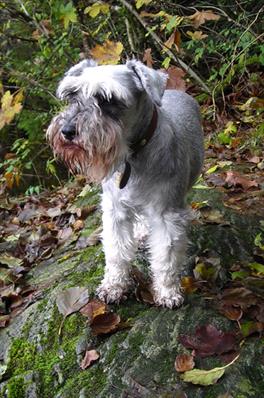Miniature Schnauzer on grass

Miniature Schnauzer. Photo courtesy of Morguefile.
What is Schnauzer comedone syndrome?
In Schnauzer comedone syndrome, dogs develop multiple comedones (blackheads) on the back and neck. These small skin bumps develop when a pore, the skin’s opening for each hair, becomes clogged with skin oils and debris. Despite the name, Schnauzer comedone syndrome can occur in non-Schnauzer breeds such as Cairn terriers and other rough-coated terriers. It is also called Schnauzer comedo syndrome, Schnauzer back, and Schnauzer back bumps.
How is it diagnosed?
Your dog’s veterinarian may need to take skin and other samples to diagnose and treat it. This is because many other skin conditions can cause comedones in dogs, including demodicosis or demodectic mange from Demodex mites.
What causes Schnauzer comedone syndrome?
No one really knows what causes Schnauzer comedone syndrome. However, it may be an inherited condition because it occurs more commonly in certain dog breeds.
How is Schnauzer comedone syndrome treated?
Schnauzer comedone syndrome cannot be curred but can be treated. To loosen and dissolve the comedones, your pet’s veterinarian may recommend a topical therapy, such as a medicated antiseborrheic shampoo or ointment. If comedones become infected, they may need to be treated with an antibiotic. Your pet’s veterinarian may take a sample for a skin culture (bacterial culture and sensitivity) to choose the antibiotic. Especially if the skin infection is itchy or painful, your pet’s veterinarian may do some tests to determine if your dog has other health conditions that are making the Schnauzer comedone syndrome bumps worse.